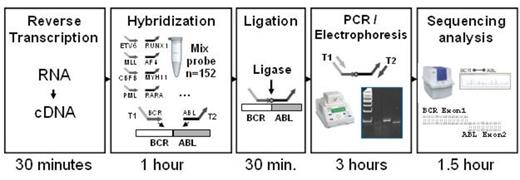Abstract
In acute leukemia, recurrent chromosomal translocations which result in the fusion of two genes are frequent. Some of these markers have a well established prognostic and therapeutic impact and are routinely screened at diagnosis by cytogenetics and RT-PCR. Yet, due to the limitations of these methods, only a few among the dozens of known rearrangements are systematically tested. Many abnormalities which could provide important clinical information thus remain ignored, mainly due to the impossibility of performing a cost effective multi-targeted screening. To overcome this obstacle, we have developed a simple and parsimonious assay which allows a reliable detection of dozens of fusion genes in only a few hours.
Our assay was designed to screen simultaneously more than 50 translocations involving 70 genes, recurrent in acute myeloid (AML), acute lymphoid (ALL) and chronic myeloid (CML) leukemia. cDNA samples obtained from leukemic cells are first incubated with a mix of oligonucleotides probes which are complementary to the ends of the exons, at the abnormal junctions on the fusion mRNAs (Figure). For most genes, different probes were designed to detect different transcripts resulting from alternative genomic breakpoints (for example on exons 1, 13, 14 and 19 for BCR, and on exons 2 and 3 for ABL). The mix we created thus regroups more than 150 probes and targets more than 400 different fusion transcripts. All left probes have a common tail (T1) at their 5' ends, all right probes a common tail (T2) at their 3' ends. Additional probes were also included to detect the most frequent mutations of NPM1 (A, B, D). If one translocation is present in the sample, two probes hybridize side to side on the fusion cDNA. A DNA ligase is next used to create a covalent link between these probes, allowing their amplification by PCR with the T1 and T2 primers. If a PCR product is amplified, the two partners are identified by sequencing analysis.
To test this method, we applied it to a retrospective series of 430 patients, (252 AML and 178 childhood ALL). In B-ALL (147 cases), all 33 ETV6-RUNX1, 6 BCR-ABL and 5 TCF3-PBX1 as well as 6 MLL rearrangements (3 AF4; 1 ENL, 1 AF9 and 1 AFF4) identified at diagnosis by conventional methods were detected, as well as 5 previously unnoticed P2RY8-CRLF2 junctions. We only failed to detect one MLL-AF4 fusion detected by cytogenetics but not by RT-PCR, probably due to the poor quality of the RNA. Further analysis of 10 MLL-AF4 positive adult ALL patients allowed the correct identification of this fusion in all cases. In T-ALL (31 cases), we detected 6 known (4 SIL-TAL, 2 CALM-AF10) and 5 previously undetected fusions (2 NUP214-ABL, 1 MLL-ENL, 1 ETV6-ABL, and a new PLZF-ABL junction). In AML, we detected 86 fusions: 23 PML-RARA, 2 PLZF-RARA, 18 CBFB-MYH11, 12 RUNX1-RUNX1T1, 4 NUP98-NSD1, 2 BCR-ABL, 1 DEK-NUP214, 1 CALM-AF10, 1 MOZ-CBP, 22 MLL rearrangements (13 PTD, 3 AF9, 2 AF6, 1 AF10, 1 ENL, 1 AF1Q and 1 MAPRE) and 44 NPM1 mutations. Two PML-RARA cases, one with a BCR2 breakpoint (not included in our design), one weakly positive by RT-PCR but negative by cytogenetics, two t(11;17) validated by FISH but negative by RT-PCR, and one NPM1J mutation (not included in our assay) were not detected. Importantly, 20 translocations in this series, including 14 MLL fusions and a cytogenetically cryptic t(8;21) had not been identified at diagnosis. Furthermore, all these new abnormalities (in AML and ALL) could be confirmed by conventional RT-PCR and sequencing analysis, demonstrating the specificity of the method. In the whole cohort of 430 patients, the three methods thus detected 157 fusions. 85 (54.1%) and 112 (71.3%) had been detected at diagnosis by cytogenetics and RT-PCR respectively, and 152 (96.8%) by our assay. Two were revealed only by cytogenetics, one only by RT-PCR and 30 only by our method.
In conclusion, we have developed a simple multiplexed assay which can reveal a very large number of recurrent gene fusions in leukemia. Its short turn-around time (we repeatedly tested up to 40 patients in parallel and the results can be obtained in less than one day) and low cost (only one PCR module, one pyrosequencer and basic molecular biology reagents are needed) make it particularly suitable for a daily practice. Its capacity to detect many abnormalities which are almost never tested in daily practice could provide many important diagnosis and prognosis information, and enable the stratification of patients in prospective clinical trials.
Ruminy:Centre Henri Becquerel: Patents & Royalties. Marchand:Centre Henri Becquerel: Patents & Royalties.
Author notes
Asterisk with author names denotes non-ASH members.


This feature is available to Subscribers Only
Sign In or Create an Account Close Modal